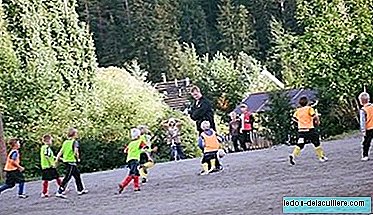
On the occasion of the World Day of physical activity, which was celebrated yesterday with the aim of transmitting the need for moderate exercise every day, we wanted to remember ten facts about physical activity that highlights the WHO.
In these data, physical activity is defined by differentiating it from sport, the important role of the activity for a healthy development is remembered, the mortality figures due to sedentary lifestyle are offered, the importance of the environment for the promotion of exercise is highlighted…
Recommendations are also offered for specific age groups and the special case of pregnant women and women who have just given birth is also mentioned. In the end we get a pretty complete idea of what are the benefits of physical activity. Let's see what these are ten facts about physical activity and its importance for health.
Physical inactivity is the fourth most important risk factor for world mortality. 6% of global deaths are attributed to physical inactivity. Only hypertension (13%) and tobacco consumption (9%) exceed it, and hyperglycemia equals it (6%). In addition, physical inactivity is the main cause of approximately 21-25% of colon and breast cancers, 27% of cases of diabetes and 30% of cases of ischemic heart disease.
Regular physical activity helps maintain a healthy body. Physically active people have: lower frequency of: coronary heart disease, high blood pressure, stroke, diabetes, colon and breast cancer, and depression; less risk of falls and vertebral or hip fractures; more likely to maintain a healthy weight.
Do not confuse physical activity with sport. Physical activity is considered any body movement produced by skeletal muscles, with the consequent energy consumption. This includes sports, exercise and other activities, such as play, walking, housework, gardening or dancing.
Physical activity is beneficial, whether it is of moderate intensity or vigorous. Intensity refers to the rhythm at which the activity is performed, that is, "the effort that one puts into performing the activity." The intensity of the different forms of physical activity varies according to people. Depending on the physical form of each, some examples of moderate physical activity they would be walking briskly, dancing or doing housework. Some examples of vigorous physical activity would be: running, riding a fast bike, swimming fast or moving heavy weights.
The group of five to 17 years. This group should perform at least 60 minutes daily of moderate or vigorous physical activity. If those 60 minutes are exceeded, more health benefits will be obtained.
The group of 18 to 64 years. Adults 18 to 64 years should perform at least 150 minutes of moderate intensity physical activity per week, or 75 minutes of vigorous physical activity, or some equivalent combination of moderate and vigorous activities. All activities should be carried out in periods of at least 10 minutes each.
Those over 65 years. The main recommendations for this group are the same as for the previous one. In addition, the elderly with low mobility should perform physical activities to improve balance and prevent falls, at least three days per week. When they cannot make the recommended amount due to health problems, they must remain as active as their capacities and health status allow.
These recommendations are relevant for all healthy adults. Unless there are medical conditions that contraindicate it, these recommendations apply to all people, regardless of sex, race, ethnicity or income level. They also apply to people with chronic noncommunicable diseases not related to mobility, such as hypertension or diabetes, and may also be valid for adults with disabilities.

It will always be better to do some activity than any. Inactive people should start doing small amounts of physical activity, and gradually increase their duration, frequency and intensity. Inactive adults, the elderly or with limitations imposed by their disease will obtain additional benefits by increasing their activity. Pregnant women, women with recent births and people with heart problems may need additional precautions and have to seek medical advice before attempting to reach recommended levels of physical activity. In the blog we have told you that in the postpartum the return to exercise must be gradual, and here you have all the information and advice about exercise during pregnancy.
Favorable environments and community support They can contribute to increasing physical activity. Urban and environmental policies have enormous potential to increase the physical activity of the population. Some examples of these policies are to ensure accessibility and safety of mobility on foot, by bicycle and with other forms of active transport, or the existence in schools of facilities and safe spaces so that students can perform physical activities during their free time.
In relation to this last point, but with implications in many of the above, all sectors and all levels of government, international partners, civil society, non-governmental organizations and the private sector have an essential role to play in the conformation of healthy environments and the promotion of physical activity.
Despite its risks, physical inactivity is increasing worldwide, in all countries. It is recommended that inactive people should start with small amounts of physical activity and gradually increase their duration, frequency and intensity.
Younger children are in the best time to establish healthy habits, so Encourage them and accompany them in their daily physical activity is our responsibility. The best way to do it: have fun playing, dancing, walking at a good pace or playing a sport ... There are a thousand ways to move and be healthier.












